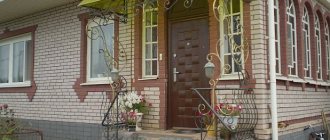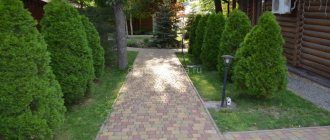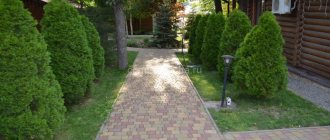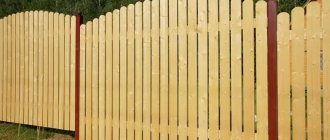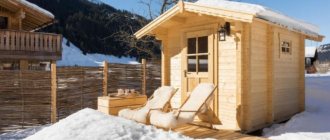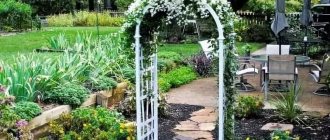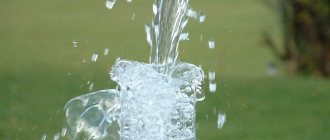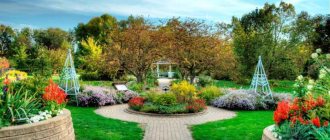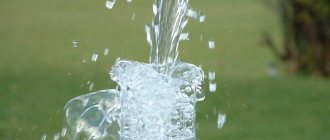For normal living, a constant supply of water is required. Multi-storey buildings and communal buildings are initially connected to the central water supply. With country houses and dachas, water supply issues will have to be resolved independently.
To solve problems, a number of difficulties will have to be overcome. Both paper and technical. However, a lot depends on how water will flow into the house.
There are two methods of water supply:
- Central (there is no need to equip a water source, a tie-in into the water main is sufficient);
- Autonomous (both delivery and digging of wells and boreholes).
Water supply at the dacha
In the recent past, the main source of water at the dacha was a well or an artesian well, on which a rocking chair was placed. There was no talk of any water supply then; the supply of water for drinking and domestic needs was organized using buckets. This required some time and effort. That is, there was no talk of any comfort.
Buckets and watering cans were even used to water the vegetable garden and replenish water supplies in the summer shower. As an option, they used metal barrels and other containers that were filled with rainwater.
A rainwater barrel for watering green spaces Source journalexpress.ca
All this did not prevent people from living outside the city. But the quality of life was not at a high level. Everything changed when the first household pumps went on sale. These were submersible units operating from an alternating current network of 200 volts. Small in size, but with fairly good performance and pressure, the pumps immediately became popular. They were simply immersed, for example, in a well or pond, from where they used to carry water in buckets, plugged into an outlet, and received a powerful pressure of water pouring out of a hose.
Craftsmen immediately realized that pumps are an opportunity to change living in a dacha and increase the comfort of living. Therefore, they immediately began to develop and implement simple, and in some cases even very simple, water supply networks.
Water supply from a European barrel with rainwater Source kohlmaier.info
Simple plumbing
The simplest water supply network, also called summer water supply, is a pump connected to an extensive system of scattered hoses. The latter are scattered throughout the area so that with their help they reach water consumers. Usually this is the construction of the dacha itself, where a sink is connected in the kitchen; on the street there is a summer shower and a tap for watering green spaces. Three points for a summer residence are the optimal condition. In addition, submersible pumps were specially designed for this purpose. That is, they do not have such a large power to supply water to a large number of consumers.
This type of water supply network received the name “summer” only because it could only be used in the summer in warm weather. In the fall, the hoses were dismantled, freed from water, twisted, the pump was pulled out from the water intake source, and all this was stored in the shed until spring.
But the most interesting thing is that such a plumbing system was inexpensive for the owners of the dacha. In addition, it was always possible to change the location of the water supply sections by moving the hose from one place in the country to another. The hose trains were connected by sections of steel pipes, usually with a diameter of 15-32 mm. Fittings in the form of tees or crosses were made from the same pipes using electric welding.
Connecting hoses for irrigation with plastic fittings Source bouw.ru
Today, metal pipes have been replaced by plastic fittings, which are sold in hardware stores. And although this type of plumbing is used less and less in suburban areas, fittings are still purchased, which means that someone else still uses it.
It should be noted that the water supply network of a pump and hoses is divided into two groups according to the methods of laying the latter: open and closed. The first is hoses simply laid on the ground. They are in plain sight, and if the owner of the dacha has no complaints about the appearance of the water supply, then this option is acceptable.
The second is hoses that are laid in prepared grooves (trenches). They are of small depth - 10-15 cm. The laid hose distribution is covered with soil, so there are no problems with the appearance of the summer cottage.
Open garden plumbing system Source gizbar.com
There is another simple option in which plastic pipes are used instead of hoses. This is usually a closed system that is buried in the ground. The pipes are distributed throughout the site to the required consumers. From them you can assemble a collapsible system or a non-dismountable one.
- The first is small sections connected to each other by ruckers , they are also a connecting element called “ American ”. That is, at any time the water supply network can be dismantled and stored in the same shed.
- The second is a non-separable system . Therefore, it is planned in advance, creating a distribution scheme for consumers. It is done once and for all . Of course, it is not a problem for the master to remake the network, for example, by cutting into the pipe distribution another section to an additionally installed consumer.
Country water supply from plastic pipes Source aqua-rmnt.com
Complex country water supply systems
In fact, water supply in a dacha can be organized, as they say, using the latest technology. There are a huge variety of water pumps and filtration systems on the market today. All this is freely available for little money. That is, today organizing an autonomous water supply system that would supply a country house with the cleanest water is not a problem. Therefore, let's look at what manufacturers offer today instead of the simplest garden water supply systems.
As is the case with simple water supply systems, water intake outside the city is organized from a well or open reservoirs. Today, another source is used - wells that are drilled to a sufficiently great depth, where the purest water lies in large quantities.
Each source uses its own pumps, because in each of them water intake is carried out differently. And since pumping equipment is energy-dependent, that is, it runs on electric current, manufacturers make sure that water and current do not meet somewhere inside the pumping unit.
Diagram of a complex country water supply Source kapustik.ru
See also: Catalog of companies that specialize in the installation of water supply and sewerage.
Types of pumps used
In dachas, three types of pumping devices are used to organize an autonomous water supply:
- Superficial . They are installed next to the source of water intake, without lowering them into the water itself. Hence, in principle, the name. A hose or plastic flexible pipe is lowered into the water, at the end of which a mesh filter is installed. The second end is connected to the pump to the suction pipe. A water supply network is laid from the device itself, or rather from the supply pipe.
Surface pump for a summer residence Source tr.decorexpro.com
- Submersible . They have already been mentioned, we’ll just add that such pumps are used only if the water intake level is not lower than 8-10 m. They are partially or completely immersed in water, hence the name of the units.
- Boreholes , they are also deep . They were specially invented for pumping water from wells, that is, from great depths. At dachas, they use devices that can be used to lift water from a depth of 50 m. Although manufacturers also offer other models that submerge to depths of over 200 m.
Borehole pump for country water supply Source strhouse.ru
Laying methods - hidden and open system
Pipes in the water supply system can be laid in closed or open ways. The choice of one of the methods does not affect the quality of the connections or the functionality of the entire system and depends only on personal preferences.
It would seem that it is not difficult to decide and the closed method is preferable as it is more aesthetic and allows saving up to 10 cm of usable space. Why is an open pipeline still used when installing a water supply system? Let's try to give an answer.
Image gallery
Photo from
Water supply made of metal-plastic pipes
Polypropylene water supply system
Water supply system using VGP pipes
Water pipes made of copper and stainless steel
Hidden wiring allows you to hide pipes and not spoil the aesthetic perception of the interior of a house or apartment. The hidden method is used when assembling a water supply system from PP pipes. They hide the contour behind a decorative wall, for example, made of plasterboard, or they groove the walls and insert pipes into the resulting niches, sealing them with facing material or plaster over a mesh.
The pipeline should not be tightly adjacent to the surfaces - always leave a small gap for possible repairs. When installing a pipeline into a monolith, it is recommended to place them in a casing, inserting the pipe into the pipe.
The disadvantage of the method appears when there is a need to repair or replace hidden elements of the system - the plaster or tiling has to be opened and then re-decorated.
In addition, in the event of damage and leaks, the problem may not be detected immediately and lead first to a loss of operational technical characteristics of the structures, then to flooding of the premises.
It is better to start installing a water supply system with a pre-drawn diagram - otherwise errors in calculations or assembly will lead to the need to cut new grooves and re-install the pipes
To avoid such difficulties, when installing the wiring, only whole sections of the pipe are hidden, placing connecting fittings in open areas. Inconspicuous doors are made in places where shut-off valves are installed. This gives access during maintenance to pipe connections, which are the weakest links in the system.
It should also be noted that pipes made of not all materials can be hidden under a layer of plaster - only products made of polypropylene, metal-plastic or copper are suitable for this.
Open pipe laying is carried out after finishing is completed. The method involves the uncovered laying of pipes and water supply elements. It looks ugly and reduces the usable area of the room, but at the same time this method is very convenient for maintenance, repair and dismantling of elements.
Redevelopment and rearrangement of plumbing in the house with such a plumbing arrangement will also not cause difficulties.
Open wiring makes it possible to quickly detect the location of a leak and eliminate the cause of breakdown or damage to system elements
Plumbing diagram
And a few words about how to properly organize an autonomous water supply network at your dacha. First of all, the issue of the source of water supply is resolved. After which the pump is selected according to its installation type. That is, these two criteria are inextricably linked. And the second comes out of the first.
And now about the layout. If submersible or borehole models of pumping equipment are used in the water supply system, then surveying the location of the devices will not be necessary. As for surface aggregates, there are two options:
- The pump is located next to the water . For example, inside a well on a platform mounted above the surface of the water. Or inside a caisson, which is a sealed container installed in the ground above a borehole or well.
- The pumping unit is located inside the house . A pipe is led from it into a well or borehole. A special room is allocated for the pump. This could be a basement or a utility room. Here, all other elements of the autonomous system are usually installed near the pump: filters, electrical control panel, switchgear, storage tank, etc.
Layout of a surface pump in the basement of a house Source moikolodets.ru
Sometimes a special room is allocated for a surface pump, which is built on the street next to the cottage. It must be insulated.
As for the pipework, these are plastic pipes that are laid at a shallow depth, but must be insulated. Fortunately, you can find special thermal insulation materials for pipes on the market. Particular attention is paid to laying pipes inside the house. Typically, such a passage is planned at the stage of forming a country house project. Because the shorter the distance from the source of water intake to the cottage, the better: less material consumption, the pressure and productivity of the water supply does not decrease. Usually the installation inside the house is carried out either through the foundation of the building or through the wall.
Separation based on water supply principle
Installation of a DHW and cold water system can be carried out in two ways:
- With “deaf” wiring. The water supply pipe to the last water intake point ends in a dead end. This scheme is more beneficial for saving space and from an economic point of view, but can create inconvenience during the operation of the water supply system. Water will flow into the last node with a delay, and only after it reaches the plug will it begin to flow into the tap.
- With closed circulation wiring. With this method, water constantly moves in a circle, has the same temperature at each point of the system and reaches the user immediately after opening the tap. The peculiarity of this wiring method is advisable to use specifically for a hot water supply system - it is important to prevent sudden temperature changes in it.
In order not to unnecessarily complicate the plumbing in the house, it is more rational to use a combined option. The cold water supply system is carried out with the help of blind wiring, the hot one - with the help of circulation.
A simple diagram immediately shows the differences between different water supply schemes: 1 - standard, “dead”; 2 - with forced circulation; 3 - “blind” using a collector
Useful tips
And some recommendations from experts:
- Before purchasing pumping equipment, it is necessary to carry out calculations for consumers . That is, calculate the optimal ratio performance and total consumption .
- preliminary piping scheme , which takes into account all consumers , regardless of their seasonal or off-season use.
- It is necessary to correctly connect the pump to the power supply network . There are many nuances here, so a professional electrician .
- The owner of the dacha must first decide whether to buy all materials and equipment separately or purchase a ready-made pumping station . It cannot be said that one of the proposed options is better than the other. Therefore, it is better to consult with specialists who will study the features of the dacha and the source of water intake.
How to create a project yourself?
In order to properly plan the plumbing system, you must first draw up a house plan, placing in it all the plumbing fixtures and equipment that will be connected to the water supply.
All dimensions are indicated on the same scale, according to actual measurements of the premises. The more accurately the plan is drawn up, the more accurately it will be possible to determine the required amount of materials and components.
The water supply diagram should reflect as accurately as possible all water intake points, the length and location of pipes for transporting water, and even sewerage, since these communications are often located nearby. The number of filters, boiler volume, and pumping equipment parameters are also taken into account.
The wiring diagram must be simplified as much as possible, trying to avoid crossing pipes. Water pipes are located closer to sewer pipes in order to hide them with a common duct. When placing pipes under the floor, the outlet of the tees is positioned straight up
The project must take into account the requirements of building regulations, as well as the rules of water supply and sanitation approved and in force in the country.
About pipes
A trench is dug across the site and water pipes are laid into it. To ensure reliable operation of the water supply system, it is better to use polyethylene or polypropylene pipes.
The dripping paths of the pipe trench must be correlated with the water supply diagram on the plan. It is better to install water pipes around the house using metal-plastic pipes.
For summer water supply, rubber or silicone pipes are used, which can be stretched over the area without a trench or hidden in shallow grooves, buried a little with earth.
Only with the onset of cold weather you need to remember to drain the water from them and put them away for storage.
When laying pipes for water supply, it is important to remember to maintain a slight slope towards the drainage of water. If you plan to use the water supply in winter, then the pipes must be insulated.
Help about collector blocks
This is a brass or steel riser with branches. It is connected to other parts of the water supply system with threaded connections. When choosing, you need to focus on the number of outlets for pipes. On average there are 6 holes. If you need more, you can connect two or more collectors. If, on the contrary, there is an extra point for commutation, it can be closed with a plug.
What are fog lights for?
In order to remove them, you need to unscrew the screws on the inside of the bumper.
During operation, it is important to prevent clouding or fogging of the optics glass. Fuse and relay panel
And so, the fog lights have been purchased, just the ones you need for your model of car, motorcycle, etc.
To prevent this, you should regularly treat their surface with special polishes at least once a month. Connect the button and the th output of the relay. There is nothing complicated about connecting fog lights, and anyone can handle this task!
During installation, you should insulate the wire connections and terminals using heat-shrinkable tubing or electrical tape. If installed correctly, you only need to adjust the luminous flux, which will be discussed below. Measure the distance from the ground to the middle of the headlight. Taking into account the fact that according to this scheme, power is supplied to the fog lamps only when the ignition is on, the decision to connect the fog lights according to this scheme allows you to automatically turn off the PTF after removing the key from the lock.
Post navigation
It is worth mentioning the cross-section of the wires, which depends on the load, that is, on the current strength. The installation order may be as follows - more precisely, to the battery terminals, two wires are installed under them, as we have already said, black and red, which go first to the left headlight on the driver's side, and then to the right.
It will serve as a guide for the light spot of the center of the second headlight. Let's list them: fuse;. Then two fog lights can be connected to each other in series. 2 WAYS TO CONNECT A CHINESE SWITCH WITH LIGHT 3 CONTACTS, 220 VOLT.
https://youtube.com/watch?v=AZjEhAsykAw
The importance of proper design
It cannot be underestimated how important it is to create a detailed design. An incorrectly created wiring diagram can lead to rapid occurrence of malfunctions - low pressure, wear, as well as various types of leaks. In fact, the designer’s task is simple - to draw lines from the central riser of an apartment building, bypassing or passing through the water heater, to each of the liquid flow points, but in reality the master is faced with a lot of nuances.
The scheme is complicated by the presence of several bathrooms, as well as the use of household appliances that require connection to a water supply. The more plumbing facilities, the higher the load on the entire system, the more complex the project needs to be created.
As a result, here are the problems that proper design can help solve:
- improves the basic characteristics of the water supply system;
- reduces installation and operating costs;
- makes it easier to carry out repair work in the future.
Tools, materials, dismantling old
Special tools for assembling residential pipelines are described above. To purchase materials, of course, you will need to calculate the footage, nomenclature and quantity locally. Dismantling old pipes is done in the usual ways. It is better to do this after installing and registering the water meter, so as not to turn off water to the floors for a long time.
We will give only one piece of advice: do not use valves with a lever. It is made of silumin or plastic and tends to break off at the most inopportune moment, just when you urgently need to close it. Take ball valves with a butterfly handle. The round, grooved handles also do not break, but wet or sweaty hands slip on them.
Advantages and disadvantages of a combined and separate bathroom
SF-mix Clack up to 0.8 m3/h
SF-mix Runxin up to 0.8 m3/h
SF-mix manual up to 0.8 m3/h
The main advantage of combining a toilet and a bathroom is the ease of wiring. In addition, due to the absence of a wall and one door frame, the useful area can be increased; a sink and even a washing machine can be placed.
There is also a minus, it is especially noticeable with a large family - it is difficult to take bath procedures for a long time when there is a line of people wanting to go to the toilet outside the door.
Where to begin
To build a water supply system in a summer cottage, you must first analyze where the pump, water supply pipes, taps, filters and water heater will be located. It is important not to forget about the need to install taps, both in the house and in several places on the site to connect watering hoses.
In case it becomes necessary to turn off part of the water supply, you can install additional water shut-off valves at the points where the pipes flow.
If the water supply system is created for the purpose of operating in the summer, then a tap must be installed at the very bottom of the water supply system so that all the water can be drained from the pipes before the onset of frost.
To start installing a water supply system you need to:
- find out how deep the soil freezes in the area;
- inspect the area for the presence of hills, lowlands and large boulders;
- find out how deep the groundwater lies;
- find out whether the area is flooded during a flood;
- calculate the cost of materials needed for work;
- determine the method of supplying electricity to the pump.
For a water supply system that will be designed to operate all year round, it is necessary to consider the insulation of pipes and pumping equipment.
In order to determine the route for laying pipes, it will be necessary to draw a diagram of the site with buildings, mark the electrical supply, and the location of large trees with overgrown roots.
DIY tool box according to drawings: instructions with step-by-step guide- Form for paths - a large selection of forms and a simple method for creating a beautiful and comfortable garden (photo + video)
Do-it-yourself snow blower - we remove snow easily, an overview of designs and types for a suburban area
To arrange a water supply with your own hands, you will need to buy special equipment, tools, and materials.
Having clarified all the details, you need to decide what the source of water and the type of future water supply will be. To do this, you can look at a photo of the water supply at your dacha and decide where to start by determining the sequence of work.
Common mistakes: how to properly install water and sewerage in an apartment
- If a pipeline with hot drinking liquid runs inside the walls, then you must take care of thermal insulation, otherwise the heat will escape to the ceilings.
- Plastic expands during use. It is necessary to make a “reserve” of space, and also wrap such a pipeline with padding polyester.
- It is necessary to check and close all end cuts with plugs, otherwise contaminants may enter the system.
- Before soldering, surfaces must be cleaned and degreased.
- Sewer and water supply elements should not intersect and interfere with the simple maintenance of one of the communications.
Calculation of required building materials
The size depends on the number of plumbing fixtures and household appliances that consume the resource. In an average apartment, usually 20-22 mm in diameter is enough for risers, and 16-18 mm for bends.
The number of fittings, as well as the total length of the pipeline, is calculated based on the project. However, we recommend taking 10% more.
Types of wells
There are only 2 main subspecies. In the first case, you can drill an artesian, which has a depth of up to 150 meters, or a regular one, “into the sand.” The second one does not go deeper than 15-50 meters.
They also differ in the time they can be used. The former last up to 50 years, and the latter usually no more than 20 years.
